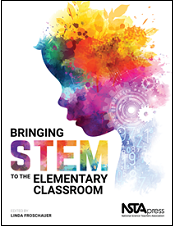Bringing STEM to the Elementary Classroom
By Carole Hayward
Posted on 2016-06-29
National initiatives, such as A Framework for K-12 Science Education and the Next Generation Science Standards (NGSS), call for an increase in both the quality and quantity of engineering content. With the addition of engineering to science classrooms, where math and technology have traditionally been included, we now have STEM (science, technology, engineering, and mathematics).
Evidence shows that 21st-century workers require skills that many graduates do not acquire through formal education. Students needs more experiences that provide in-depth knowledge of the STEM disciplines and apply to problem solving.
 In Bringing STEM to the Elementary Classroom, edited by Linda Froschauer, the authors of each chapter are initiating STEM strategies as they work toward also meeting the requirements of the NGSS. The book’s 36 lessons, organized by grade-level bands, provide the important elements needed for an effective STEM experience.
In Bringing STEM to the Elementary Classroom, edited by Linda Froschauer, the authors of each chapter are initiating STEM strategies as they work toward also meeting the requirements of the NGSS. The book’s 36 lessons, organized by grade-level bands, provide the important elements needed for an effective STEM experience.
Linda Froschauer explains that “STEM should involve problem-solving skills, serve all students equally well, encourage learning across disciplines, promote student inquiry, engage students in real-world problem solving, and expose students to STEM careers. Meeting these needs requires a continuum of learning with a focus on elements that will develop the skills and content over time and through many experiences. Whether you are just beginning to delve into STEM experiences or you have been building STEM lessons and are now seeking new ideas, this book will provide you with new, interesting, and productive strategies.”
The variety of strategies and topics used throughout the book include:
- Lessons using the BSCS 5Es
- Tested, reliable, and even some original design processes
- Pre-assessment strategies and evaluation rubrics
- Data sheets and learning tools that are readily available for immediate printing and use
- Use of technologies—from digital notebooks to three-dimensional printing
- Challenges that relate to real-world problems, such as filtering water, recycling waste, and collecting water
- Design constructions that solve problems, such as a soundproof wall, wind turbines, moving objects, solar ovens, structures to withstand harsh weather, and protections for living things
- Experiences to develop an understanding of technology
The first two chapters provide strategies that you can use at many grade levels. Chapter 1 introduces you to the process of designing STEM lessons, and Chapter 2 will assist you in identifying the misconceptions of students who are new to STEM.
Check out the sample chapter: “A House for Chase the Dog.” This book is also available as an e-book.
Follow NSTA
Disclaimer: The views expressed in this blog post are those of the author(s) and do not necessarily reflect the official position of the National Science Teaching Association (NSTA).


